Difference between revisions of "Manual EXRX"
(New Manual) |
(Fixed qty of IC sockets and plural vs singular grammer in Step 3.) |
||
| Line 146: | Line 146: | ||
| − | Install the 28 | + | Install the 28 pin Socket. Line the notch on the socket with the notched end of the drawing on the pcb and then solder all the pins. |
| Line 152: | Line 152: | ||
| − | Install | + | Install the two 2 pin and the one 6 pin headers. Make sure you look at them and put the small pins through the hole and point the longer pins up. |
| Line 159: | Line 159: | ||
<center>[[Image:Le-wireless-5.jpg]]</center> | <center>[[Image:Le-wireless-5.jpg]]</center> | ||
| − | Now install your 100uf cap near the bottom left make sure the black | + | Now install your 100uf cap near the bottom left make sure the black strip is away from the + marking on the board. |
| − | Install the LD1117 voltage regulator making sure you have it in the correct location and turned the correct way. The metal | + | Install the LD1117 voltage regulator making sure you have it in the correct location and turned the correct way. The metal back of the regulator should be towards the PIC chip socket (28 pin) as shown above. |
Revision as of 05:55, 25 July 2009
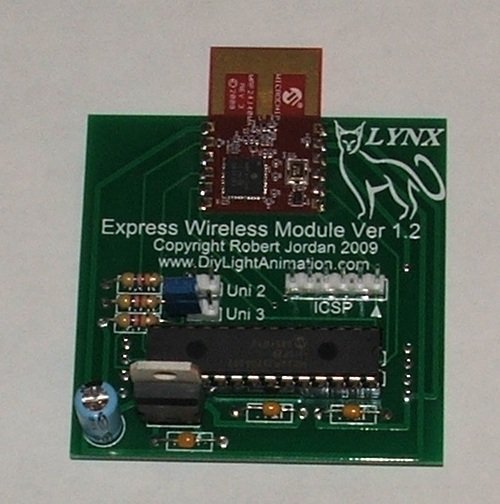
Contents
Introduction
Thank you for making the decision to build the LYNX DMX Express Receiver. I believe this decision will be one you will be very happy with.
WARNING! This device uses potentially deadly voltages in operation. If you do not feel it is within your ability to work with these voltages please stop and get assistance, or purchase ready built commercial Equipment. This Equipment has been design for personal use as a means of education and entertainment. As such it is not rated, tested, or approved for use in commercial environments and as such is forbidden by the designer. Improper use of this equipment could be hazardous to life and property and the suitability of use is your responsibility. I assume no responsibility in the use or operation of this equipment or for the accuracy of any information made on part of itself. This device has been design for my use and my use only. This is simply an explanation of how I built my own personal equipment for informational purposes. I make no warranties written or otherwise to it. It should be considered an experimental device with possible unknown characteristics.
Before we start assembly of the Module we want to do two things. First we need to take inventory and make sure we have all the components that should have come with the coop kit. Using the list on the next page verify you have the correct parts and quantity of parts before we proceed any farther. Please use static precautions in the handling of these parts. If you are not familiar in them please research on the internet prior to handling them. You can damage you parts with improper handling!
Parts List
| Mouser Part # | Description | Quantity |
| 538-70543-0003 | SL Connectors VERTICAL HDR 4P single row | 2
|
| 517-974-01-04-RK | .100" Board Mount Connectors 4P 1ROW STRT SOCKET | 2
|
| 538-22-03-2061 | .100 K.K. Connectors VERT PCB HDR 6P TIN PLATING | 1
|
| 649-65474-002LF | Bergcon Connectors SHUNT TIN | 1
|
| 581-SA105E104Z | Axial Ceramic Capacitors 50volts 0.1uF Z5U | 3
|
| 538-22-03-2021 | .100 K.K. Connectors VERT PCB HDR 2P TIN PLATING | 2
|
| 291-4.7K-RC | 1/4W 5% Carbon Film Resistors 4.7Kohms | 3
|
| 511-LD1117V33 | Low Drop Voltage Regulators/Drivers 3.3V 0.8A Positive | 1
|
| 140-XRL25V100-RC | Radial Electrolytic Capacitors 25V 100uF 20% | 1
|
| 579-PIC24FJ32GA002SP | PICmicro PIC24FJxxx Flash MCUs 32KB 8192 bytes 16MIPS 21 I/O | 1
|
| 571-1-390261-9 | IC Sockets 28P ECONOMY TIN SKT | 1
|
| 579-MRF24J40MA-I/RM | RF Transceivers 2.4GHz IEEE 802.15.4 Transceiver Module | 1
|
Preparing to Build
I trust you have everything you should you have.
The next thing we want is to make sure you are up to speed on soldering and electrostatic protection of the components in your kit. If you are not an experienced printed circuit builder I recommend you visit the site:
http://curiousinventor.com/guides/How_To_Solder
And check out there extremely good video on soldering correctly. Even if you are an expert it is a good video to watch.
Another issue you must be aware of is that some electronic components can be damaged easily by electrostatic charges that can build up in you or your equipment. We have all been shocked by walking on carpet and grabbing a door knob before. This is electrostatic charge in action. It takes much less than this to hurt some of our parts. If you are unfamiliar with procedures to protect from this please use the internet to research it before opening your parts up. You can damage your parts if handled wrong!
You will need a few tools that do not come with your kit to build the Transmitter. You will need a good soldering iron. I can not stress enough that a good soldering iron makes a big difference in these projects. The little 15w cheap irons are more apt to hurt your parts by taking too long to get the parts up to soldering temperature than a good iron which can bring it up to temp very fast. Remember it is more how long you keep the part hot than it is how hot you get it within reasonable soldering temperatures. A good soldering iron can be had for very reasonable amounts of money. You can purchase one for $30 to $60 dollars. Most anything that is called a soldering station where there is a temperature control separate from the iron itself will more than likely be fine but make sure it is rated for more than 15 watts. I myself use a cheap Weller like this one
http://www.amazon.com/Weller-Soldering-Station-WLC100-120V/dp/B000ICEMYA
It works fine and is very inexpensive. I even saw this model on sale at Sears. Radio shack has a very nice looking digital model on sale but be careful as it does not allow you to replace the tip. Tips are a part that wear out and need replacing from time to time. While we are on tips get some. I recommend you get the smaller chisel shape as this work very well for all around board building.
You need solder so buy some. I recommend .032 size (0.8mm or 0.7mm) as the larger sizes tend to cause you to put too much solder on. How much? Go ahead and get a 1 lb spool as it’s cheaper in large volume and you will go through it faster than you think. Make sure you are getting rosin core for electronics they make some solder for plumbing that has acid as the core this is a bad mistake to make.
You need some work area to work with good lighting. Do not attempt to solder circuit boards in poorly lighted areas. If you wear reading glasses go get them you will want them I promise you. I recommend a set of helping hands like this: http://www.radioshack.com/product/index.jsp?productId=2104639&cp=&parentPage=search
Step 1
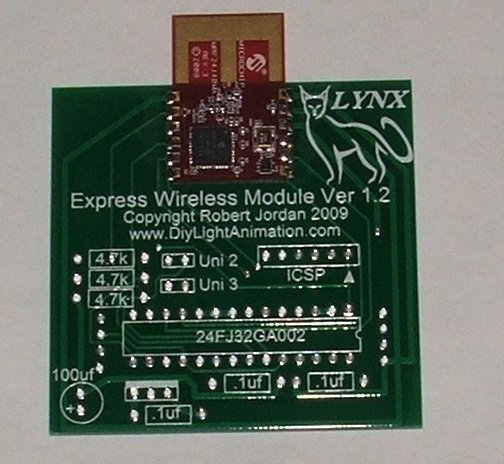
OK we are ready to start assembly of the Module. I recommend you install the RF module on the PCB first. Align its pads centered on the pads of the pcb and while holding light pressure with your finger carefully on the larger black chip touch your clean soldering iron tip point into the notch of one of the corner pads of the module and after about a second to heat it touch a slight amount of solder to the top of the pad and iron tip at the same time. It will flow and wick onto the pad of the pcb and make a connection.
Now do the same at the opposite corner pad and this will lock the module in place. Now you can let go of the Rf module and do the same soldering on the other pads.
Step 2
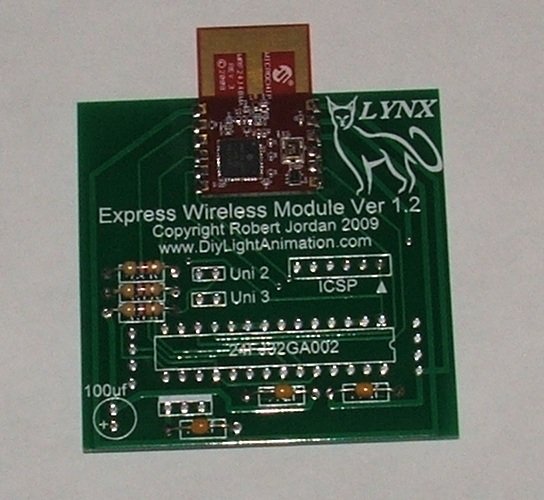
Now install all of the resistors in there proper place. There are 3 4.7k ohm resistors right together on the left side half way up the board. Resistors do not have a wrong direction but I always put the color bands the same direction to make it look professional.
Now find the location for the three .1uf caps and install them. There is no wrong direction for these.
Step 3
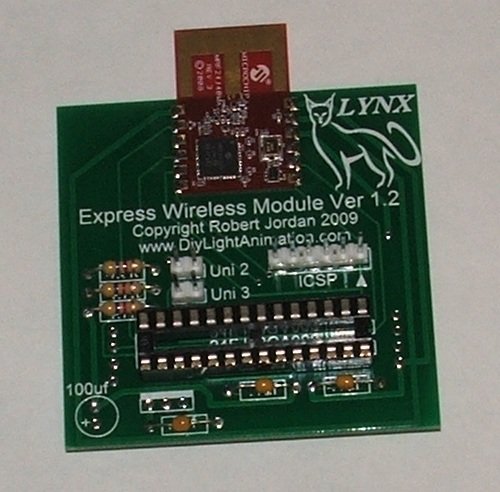
Install the 28 pin Socket. Line the notch on the socket with the notched end of the drawing on the pcb and then solder all the pins.
Everyone has their own way of holding the socket in until they are soldered in. I like to turn the board over to the back and put the least amount of solder I can over one of the middle holes on one side of the socket. This allows you to put the pins of the other side of the socket through and hold the socket while pushing extremely easy. Then you heat that one hole on the back. When the solder melts the socket will drop in. remove the iron and it will cool and hold the socket in until you are done. Make sure to reheat this pin while doing the others to insure you have a good joint. Some people prefer to use tape to hold them in and some even super glue them on first and then solder. If you use tape then the painter’s masking tape is a good option as it does not leave any residue behind when it is removed. Make sure your socket is in the correct holes and that it faces the correct way and then solder the other pins in. If you are happy with it you can go ahead and start soldering the other sockets in. And check each one for direction before soldering it. Pay careful attention that you are putting the right size socket in the correct set of holes
Install the two 2 pin and the one 6 pin headers. Make sure you look at them and put the small pins through the hole and point the longer pins up.
Step 4
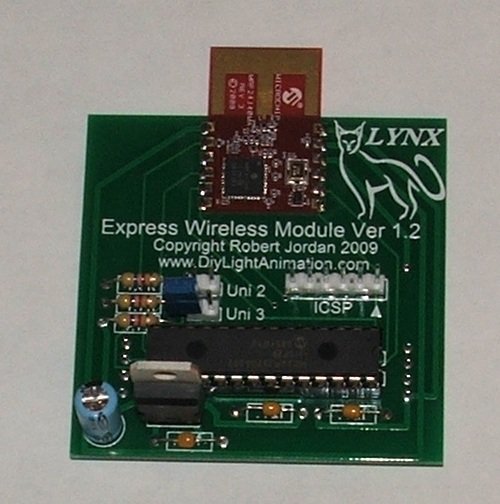
Now install your 100uf cap near the bottom left make sure the black strip is away from the + marking on the board.
Install the LD1117 voltage regulator making sure you have it in the correct location and turned the correct way. The metal back of the regulator should be towards the PIC chip socket (28 pin) as shown above.
Step 5
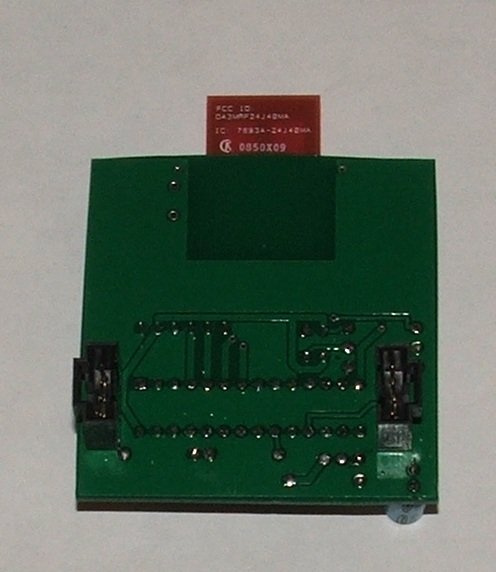
Last step is to add the connectors. The shrouded male connector goes on the module and the female socket goes on the Express pcb. Before installing them, put the male and female together. Then slide them in place on the module and slide all of this onto your Express. When the assembly is square, solder the pins to the module. Flip the entire assembly (LE and module) over and solder the pins to the LE. This will align it all straight. Otherwise if done apart it may not line up close enough to fit. The connectors fit kind of tight which is a good thing but means they must line up correctly.
If you have several modules to assemble, recommend that you use the one LE with female connectors attached to align the shrouded male connectors on all of the modules.
Caution: Solder all four pins on each of the connectors before removing the module from the LE.
Sit back take a deep breath you did it! Pat yourself on the back and have a cold whatever it is you enjoy.
Thank you, enjoy your Receiver
RJ